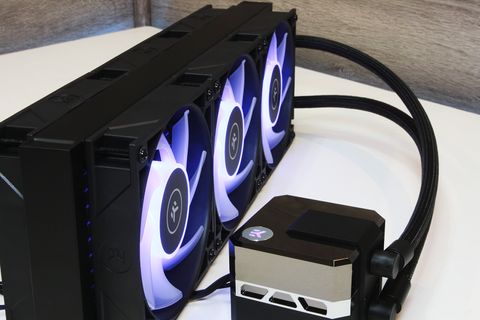Why you can trust Tom's Hardware

Right away we see the EK AIO Elite 360 D-RGB narrowly edging out some of the most impressive 360 AIOs we’ve previously covered. There is a noticeable difference in the motherboard power delivery modules and their prominent heatsink. This is likely due to the additional fan thickness, which extends slightly beyond where this heatsink is orientated on our motherboard in reference to the mounted AIO Elite 360.

The Vardar fans used by the EK AIO Elite 360 are the fastest spinning of our testing group, which is likely to lead to a noticeable difference in noise level -- especially given that there are six of them.
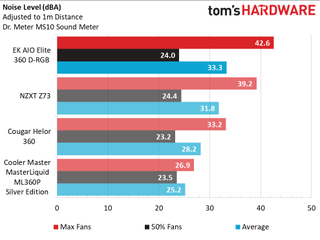
Making use of six high-speed fans on a single cooler is likely to cause a bit of stir, both in auditory and airflow terms. The EK AIO Elite 360 gets rather noisy with all fans set to 100%, so make sure to take some time and give your system the fan curve it needs to keep things cool and relatively quiet.
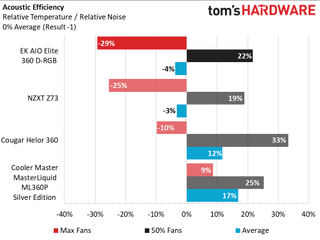
While they might perform well, measured noise levels of our AIO testing group impact our acoustic efficiency chart where we make consideration for how well a cooler performs under heavy use by how loudly they operate as they excise thermal loads.
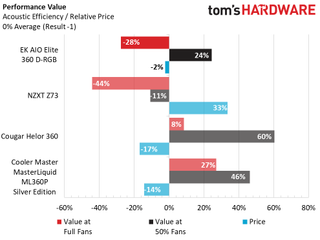
At release, the EK AIO Elite 360 D-RGB is set to be priced right at $200 from the EKWB web shop, available from Newegg and Amazon later in December. The large hit we saw from the acoustic results weigh heavily on our performance value results, as unit pricing is evaluated, but not all is lost.
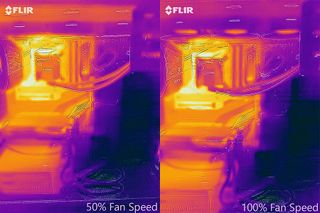
Thermal imaging from our FLIR ONE Pro camera shows a noticeable difference of heat soak along the lateral length of the 360mm radiator as well as some splotching across the face of the pump itself. We also see a marked difference along the tubing between the pump and radiator, where we see lower thermal markers in the same locations under full fan RPM vs half PWM.
Full speed also sees the heat bloom at the center of the fan hubs, due to power consumption and friction at full speed, while this is not as visible at lower RPM.
The EK AIO Elite 360 D-RGB provides the masses with the first 360mm AIO with push+pull fan configuration right out of the box. One caveat does exist for a cooler utilizing six high-speed fans, as it can make quite a fuss when running at full speed and will need a well-defined fan curve to help keep noise levels under control. At $200 at launch, it’s also expensive, though if you’ve already shelled out for the CPU hardware (and surrounding system) required to push this cooler to its limits, a bit extra for a few more fans is almost certainly a comparative pittance.

Garrett Carver is a contributor for Tom’s Hardware, primarily covering thermal compound comparisons and CPU cooling reviews; both air and liquid, including multiple variations of each.

Award-winning Chinese processor design company Huaxia Chip files for bankruptcy — firm’s CPU, DSP, GPU, and AI processor IPs in limbo

AMD unveils Ryzen Pro 8000-series processors — Zen 4 and AI engines come to the commercial market

Asus ROG Swift PG49WCD 49-inch gaming monitor review: The most colorful OLED yet
-
nofanneeded A small hint to EK, which is better ? double the fans or doubling the thickness of the radiator ?Reply
The answer is : Double the Radiator is better . that more thickness is wasted. -
PlanesFly Replynofanneeded said:A small hint to EK, which is better ? double the fans or doubling the thickness of the radiator ?
The answer is : Double the Radiator is better . that more thickness is wasted.
What you neglected to reason out is that 50-60mm radiators need push/pull to work best. Thick radiators also require higher airflow to get the benefit as they are 2 pass and without elevated airflow the 2nd pass nets you little. -
nofanneeded ReplyPlanesFly said:What you neglected to reason out is that 50-60mm radiators need push/pull to work best. Thick radiators also require higher airflow to get the benefit as they are 2 pass and without elevated airflow the 2nd pass nets you little.
True but thats for optimal result . it is still better result with double thick Radiator VS push pull fans and half the radiator. -
Smackaroy Wonder why it performance is a bit better than the other aios, It has 3 extra fans for god sake! this just proves that all aios perform the same it just depends what fans you put on itReply -
TallentedOne I'm curious why you have been using the ML360P Silver Edition in recent comparisons instead of the ML360R? Your own review of the Silver Edition (https://www.tomshardware.com/reviews/cooler-master-masterliquid-ml360p-silver-edition,6341.html) showed it performed worse from a cooling perspective compared to the ML360R.Reply -
Phaaze88 Well, that's a waste.Reply
Surely the manufacturers/engineers know what's holding back performance on hybrid coolers isn't moar fans and moar radiator, but what's on the other end?
¯\(ツ)/¯ -
Darkbreeze Reply
Not higher "airflow" but higher static pressure. You can put fans with 200CFM on there, but if they have .098mm H20 static pressure, they aren't going to do much. In fact, they'll probably do a lot of stalling and suffer from major inversion leakage. A fan with 70CFM and a 2.5mm H20 static pressure however, will likely handle the thicker radiator, or heatsink, just fine.PlanesFly said:What you neglected to reason out is that 50-60mm radiators need push/pull to work best. Thick radiators also require higher airflow to get the benefit as they are 2 pass and without elevated airflow the 2nd pass nets you little.
With 3.16mm H20 static pressure, those 120mm Vardar 120ER RGB fans can likely push their 77CFM through a thicker radiator just fine. Or this radiator for that matter. I'd like to see the same tests done again with ONLY the front three fans installed, to compare the difference. I imagine there isn't a terrific difference, maybe 1-5°C, which makes the cost of the additional three fans that are tacked onto the price of this unit somewhat hard to swallow. Barring some astounding different in performance between a three fan setup compared to six, I'd prefer to see them take the cost of three fans off and sell the unit as is or as mentioned, maybe with a thicker radiator. Those fans have plenty of static pressure and CFM to handle it I think.
It would also be a heck of a lot quieter with only three fans running full out, rather than six. -
Asryan I have the previous version of this aio but might have to rma it.Reply
I am not sure i can fit a push pull but does the new pump makes a difference without being extra noisy at this pump rpm?
